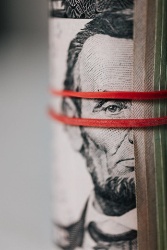The Faces Behind the Faces on the Most Wanted Deck
The Faces Behind the Faces on the 'Most Wanted' Deck
By
Sgt. 1st Class Doug Sample
American Forces Press
Service
WASHINGTON, May 6, 2003 — The faces of Saddam Hussein's defeated regime on the now-famous "most wanted" card deck have become ever familiar with more than 1 million decks printed and sold.
The faces of the cards' creators, however, were a mystery, until now, that is.
Enter
Army Staff Sgt. Shawn Mahoney, 31, and Sgt.
Scott
Boehmler, 27, of the 3401st Military
Intelligence
Detachment; 2nd Lt. Hans Mumm, 34, of the
3404th MI Det.;
Spc. Joseph Barrios, 31, of the 3418th MI
Det.; and Sgt.
Andrei Salter, 31, of the Defense
Intelligence Agency.
But it was not for Salter and the reservists from these Pennsylvania-based units to say they were the innovative forces behind one of Operation Iraqi Freedom's most sought- after treasures. "In the intelligence community we don't like to put ourselves out there like the regular services," Salter said, explaining the intelligence agency's "thumbs up" to their identity and contributions.
Cards showing 'ace' of spades Saddam Hussein and 54 other regime members have become hits around the world, especially in the United States. So far, 17 of the Iraqi most wanted have surrendered or been taken into custody. The cards' popularity on the Internet had dealers at one point listing prices upwards of $100 per deck, Mumm said.
The decks average about $5 on most Web sites now. One U.S. company has sold more than 1.5 million decks.
"This was the real 'shock and awe," Barrios said, referring to the coined phrase used in initial attacks during Iraqi Freedom. "We were really surprised at how successful they've become."
"As people started to get captured, they wouldn't say who the person was that got captured. They'd say, 'They captured the '6' of diamonds out of the deck of cards,'" Mumm explained. "That was the amazing part."
The soldiers said the idea for the cards came about when they were looking for ways to get information to battlefield troops on Iraqis sought by the United States.
"Our thought was that we've all been out in the field and we all know what it's like to be in a foxhole and to be bored and tired, so we decided to look at an inventive way, something soldiers would actually use," Mumm said.
The group said they knew that when soldiers get bored, they play cards, Mahoney explained. "Anyone will tell you that when you're out in the field and you have some down time, you're either playing (games like) Hearts or Spades."
The group then decided that putting the faces of Iraqi regime members wanted by the United States on the cards would help soldiers to remember them and aid in their capture. The cards, they said, are numbered loosely on the rank structure in the Iraqi regime.
"Even if you're not studying the cards, you're retaining information subconsciously," Mahoney said. "You might not know the name, but if the soldier sees someone he might think, 'That person looks mighty familiar.' That's when you start to pick people out of the crowd," he added.
The soldiers showed their idea to Army Col. Susan Kuwana, senior military intelligence commander for the 99th Reserve Operations Command, which includes their detachments.
"I thought this was a terrific idea. It was creative, innovative and very effective," Kuwana said. "To come in and have an opportunity to bring that innovation and creativity to the active duty has been a tremendous success story for the Reserves."
The group said the project to make the cards began in February, but the coordination took awhile. The hardest part of the project was finding photos of Saddam's regime members, Boehmler said.
The intelligence community played a big part in locating the photos, and the group used the print shop within their agency to print the first deck of cards, he explained.
Not sure what the initial reaction would be, the soldiers printed only two decks to show their chain of command.
"I recalled we had a discussion where we sort of did the 'devil's advocate' thinking on what are the bad things that could come out of this," Boehmler said. "All we got was positive feedback, but we never expected it to go so positive."
Two hundred decks of the cards were sent to the U.S. Central Command's forward-deployed headquarters in Qatar for troops' operational use only, Mumm said. CENTCOM then requested 1,700 more decks for troops in the theater.
Army Brig. Gen. Vincent Brooks, the command's deputy operations officer, showed the cards during a televised operational briefing, and they started appearing on DoD Web sites. From there, every entrepreneur in America wanted to get his hands on them, Mumm said.
ENDS


 Médecins Sans Frontières: Concern Over Planned Deportation Of Afghan Refugees In Pakistan
Médecins Sans Frontières: Concern Over Planned Deportation Of Afghan Refugees In Pakistan European Cultural Centre: Time Space Existence 2025 - A Collective Call To Repair, Regenerate, And Reuse
European Cultural Centre: Time Space Existence 2025 - A Collective Call To Repair, Regenerate, And Reuse John P. Ruehl, IMI: What Will Tech Moguls Do With Their Wealth?
John P. Ruehl, IMI: What Will Tech Moguls Do With Their Wealth? ITUC: Workers Must Not Pay The Price Of An Imposed Trade War
ITUC: Workers Must Not Pay The Price Of An Imposed Trade War Greenpeace: Major Deep Sea Mining Company Goes Bankrupt
Greenpeace: Major Deep Sea Mining Company Goes Bankrupt New Zealand Defence Force: Indian And New Zealand Navies Involved In $181m Drug Bust In Indian Ocean
New Zealand Defence Force: Indian And New Zealand Navies Involved In $181m Drug Bust In Indian Ocean